Ford Model T
| Ford Model T | |
|---|---|
 1919 Ford Model T Coupe | |
| Overview | |
| Manufacturer | Ford Motor Company |
| Production | 1908–1927 |
| Assembly |
|
| Designer | Henry Ford, Childe Harold Wills, Joseph A. Galamb and Eugene Farkas |
| Body and chassis | |
| Class | Full-size Ford, economy car |
| Body style |
|
| Layout | FR layout |
| Powertrain | |
| Engine | 177 C.I.D. (2.9 L) 20 hp I4 |
| Transmission | 2-speed planetary gear |
| Dimensions | |
| Wheelbase | 100.0 in (2,540 mm) |
| Length | 134 in (3,404 mm) |
| Curb weight | 1,200 pounds (540 kg) |
| Chronology | |
| Predecessor | Ford Model S |
| Successor | Ford Model A |
The Ford Model T (colloquially known as the Tin Lizzie, T‑Model Ford, Model T, T, Leaping Lena, or flivver) is an automobile that was produced by Ford Motor Company from October 1, 1908, to May 26, 1927.[6][7] It is generally regarded as the first affordable automobile, the car that opened travel to the common middle-class American; some of this was because of Ford's efficient fabrication, including assembly line production instead of individual hand crafting.[8]
The Ford Model T was named the most influential car of the 20th century in the 1999 Car of the Century competition, ahead of the BMC Mini, Citroën DS, and Volkswagen Type 1.[9] Ford's Model T was not only successful because it provided inexpensive transportation on a massive scale, but also because the car signified innovation for the rising middle class and became a powerful symbol of America's age of modernization.[10] With 16.5 million sold it stands eighth on the top ten list of most sold cars of all time as of 2012.[11]
Although automobiles had already existed for decades, they were still mostly scarce and expensive at the Model T's introduction in 1908. Positioned as reliable, easily maintained mass market transportation, it was a runaway success. In a matter of days after the release, 15,000 orders were placed.[12] The first production Model T was produced on August 12, 1908[13] and left the factory on September 27, 1908, at the Ford Piquette Avenue Plant in Detroit, Michigan. On May 26, 1927, Henry Ford watched the 15 millionth Model T Ford roll off the assembly line at his factory in Highland Park, Michigan.[14]
There were several cars produced or prototyped by Henry Ford from the founding of the company in 1903 until the Model T was introduced. Although he started with the Model A, there were not 19 production models (A through T); some were only prototypes. The production model immediately before the Model T was the Model S,[15] an upgraded version of the company's largest success to that point, the Model N. The follow-up was the Ford Model A (rather than any Model U). The company publicity said this was because the new car was such a departure from the old that Henry wanted to start all over again with the letter A.
The Model T was Ford's first automobile mass-produced on moving assembly lines with completely interchangeable parts, marketed to the middle class.[16] Henry Ford said of the vehicle:
I will build a car for the great multitude. It will be large enough for the family, but small enough for the individual to run and care for. It will be constructed of the best materials, by the best men to be hired, after the simplest designs that modern engineering can devise. But it will be so low in price that no man making a good salary will be unable to own one – and enjoy with his family the blessing of hours of pleasure in God's great open spaces.[17]
Although credit for the development of the assembly line belongs to Ransom E. Olds with the first mass-produced automobile, the Oldsmobile Curved Dash, beginning in 1901, the tremendous advancements in the efficiency of the system over the life of the Model T can be credited almost entirely to the vision of Ford and his engineers.[18]
Characteristics

The Model T was designed by Childe Harold Wills, and Hungarian immigrants Joseph A. Galamb[19] and Eugene Farkas.[20] Henry Love, C. J. Smith, Gus Degner and Peter E. Martin were also part of the team.[21] Production of the Model T began in the third quarter of 1908.[22] Collectors today sometimes classify Model Ts by build years and refer to these as "model years", thus labeling the first Model Ts as 1909 models. This is a retroactive classification scheme; the concept of model years as we conceive it today did not exist at the time. The nominal model designation was "Model T", although design revisions did occur during the car's two decades of production.
Engine

The Model T had a front-mounted 177-cubic-inch (2.9 L) inline four-cylinder engine, producing 20 hp (15 kW), for a top speed of 40–45 mph (64–72 km/h). According to Ford Motor Company, the Model T had fuel economy on the order of 13–21 mpg-US (16–25 mpg-imp; 18–11 L/100 km).[23] The engine was capable of running on gasoline, kerosene, or ethanol,[24][25] although the decreasing cost of gasoline and the later introduction of Prohibition made ethanol an impractical fuel for most users.
The ignition system used an unusual trembler coil system to drive the spark plugs, as used for stationary gas engines, rather than the expensive magnetos that were used on other cars. This ignition also made the Model T more flexible as to the quality or type of fuel it used. The need for a starting battery and also Ford's use of an unusual AC alternator located inside the flywheel housing encouraged the adoption of electric lighting (standard fitment as of 1915), rather than oil or acetylene lamps, but it also delayed the adoption of electric starting, which was not offered until 1919.[26]
Transmission and drive train

.jpg)
The Model T was a rear-wheel drive vehicle. Its transmission was a planetary gear type billed as "three speed". In today's terms it would be considered a two-speed, because one of the three speeds was reverse.
The Model T's transmission was controlled with three foot pedals and a lever that was mounted to the road side of the driver's seat. The throttle was controlled with a lever on the steering wheel. The left pedal was used to engage the gear. With the floor lever in either the mid position or fully forward and the pedal pressed and held forward the car entered low gear. When held in an intermediate position the car was in neutral. If the left pedal was released, the Model T entered high gear, but only when the lever was fully forward – in any other position the pedal would only move up as far as the central neutral position. This allowed the car to be held in neutral while the driver cranked the engine by hand. The car could thus cruise without the driver having to press any of the pedals. There was no separate clutch pedal.
When the car was in neutral, the middle pedal was used to engage reverse gear, and the right pedal operated the transmission brake – there were no separate brakes on the wheels. The floor lever also controlled the parking brake, which was activated by pulling the lever all the way back. This doubled as an emergency brake.
Although it was uncommon, the drive bands could fall out of adjustment, allowing the car to creep, particularly when cold, adding another hazard to attempting to start the car: a person cranking the engine could be forced backward while still holding the crank as the car crept forward, although it was nominally in neutral. As the car utilized a wet clutch, this condition could also occur in cold weather, when the thickened oil prevents the clutch discs from slipping freely. Power reached the differential through a single universal joint attached to a torque tube which drove the rear axle; some models (typically trucks, but available for cars as well) could be equipped with an optional two-speed Ruckstell rear axle shifted by a floor-mounted lever which provided an underdrive gear for easier hill climbing. All gears were vanadium steel running in an oil bath.
Transmission bands and linings
Two main types of band lining material were used:[27]
- Cotton – Cotton woven linings were the original type fitted and specified by Ford. Generally, the cotton lining is "kinder" to the drum surface, with damage to the drum caused only by the retaining rivets scoring the drum surface. Although this in itself did not pose a problem, a dragging band resulting from improper adjustment caused overheating transmission and engine, diminished power, and – in the case of cotton linings – rapid destruction of the band lining.
- Wood – Wooden linings were originally offered as a "longer life" accessory part during the life of the Model T. They were a single piece of steam bent cottonwood fitted to the normal Model T transmission band. These bands give a very different feel to the pedals, with much more of a "bite" feel. The sensation is of a definite "grip" of the drum and seemed to noticeably increase the feel, in particular of the brake drum.
Suspension and wheels

Model T suspension employed a transversely mounted semi-elliptical spring for each of the front and rear beam axles which allowed a great deal of wheel movement to cope with the dirt roads of the time.
The front axle was drop forged as a single piece of vanadium steel. Ford twisted many axles through eight full rotations (2880 degrees) and sent them to dealers to be put on display to demonstrate its superiority. The Model T did not have a modern service brake. The right foot pedal applied a band around a drum in the transmission, thus stopping the rear wheels from turning. The previously mentioned parking brake lever operated band brakes acting on the inside of the rear brake drums, which were an integral part of the rear wheel hubs. Optional brakes that acted on the outside of the brake drums were available from aftermarket suppliers.
Wheels were wooden artillery wheels, with steel welded-spoke wheels available in 1926 and 1927.
Tires were pneumatic clincher type, 30 in (76 cm) in diameter, 3.5 in (8.9 cm) wide in the rear, 3 in (7.5 cm) wide in the front. Clinchers needed much higher pressure than today's tires, typically 60 psi (410 kPa), to prevent them from leaving the rim at speed. Horseshoe nails on the roads, together with the high pressure, made flat tires a common problem.
Balloon tires became available in 1925. They were 21 in × 4.5 in (53 cm × 11 cm) all around. Balloon tires were closer in design to today's tires, with steel wires reinforcing the tire bead, making lower pressure possible – typically 35 psi (240 kPa) – giving a softer ride. The old nomenclature for tire size changed from measuring the outer diameter to measuring the rim diameter so 21 in (530 mm) (rim diameter) × 4.5 in (110 mm) (tire width) wheels has about the same outer diameter as 30 in (76 cm) clincher tires. All tires in this time period used an inner tube to hold the pressurized air; "tubeless" tires were not generally in use until much later.
Wheelbase was 100 inches (254 cm) and standard tread width was 56 in (142 cm); 60 in (152 cm) tread could be obtained on special order, "for Southern roads", identical to the pre-Civil War track gauge for many railroads in the former Confederacy.
Colors
By 1918, half of all the cars in the US were Model Ts. However, it was a monolithic bloc; Ford wrote in his autobiography that in 1909 he told his management team that in the future “Any customer can have a car painted any color that he wants so long as it is black”.[28]
However, in the first years of production from 1908 to 1913, the Model T was not available in black[29] but rather only gray, green, blue, and red. Green was available for the touring cars, town cars, coupes, and Landaulets. Gray was only available for the town cars, and red only for the touring cars. By 1912, all cars were being painted midnight blue with black fenders. It was only in 1914 that the "any color so long as it is black" policy was finally implemented. It is often stated that Ford suggested the use of black from 1914 to 1926 due to the cheap cost and durability of black paint. During the lifetime production of the Model T, over 30 types of black paint were used on various parts of the car.[29] These were formulated to satisfy the different means of applying the paint to the various parts, and had distinct drying times, depending on the part, paint, and method of drying.
Body

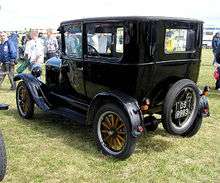
Although Ford classified the Model T with a single letter designation throughout its entire life and made no distinction by model years, there were enough significant changes to the body over the production life that the car can be classified into five distinct generations. Among the most immediately visible and identifiable changes were in the hood and cowl areas, although many other modifications were made to the vehicle.
- 1909–1914 – T1 – Characterized by a nearly straight, five-sided hood, with a flat top containing a center hinge and two side sloping sections containing the folding hinges. The firewall was flat from the windshield down with no distinct cowl.
- 1915–1916 – T2 – The hood design was nearly the same five sided design with the only obvious change being the addition of louvers to the vertical sides. There was a significant change to the cowl area with the windshield relocated significantly behind the firewall and joined with a compound contoured cowl panel.
- 1917–1923 – T3 – The hood design was changed to a tapered design with a curved top. the folding hinges were now located at the joint between the flat sides and the curved top. This is sometime referred to as the low hood to distinguish if from the later hoods. The back edge of the hood now met the front edge of the cowl panel so that no part of the flat firewall was visible outside of the hood. This design was used the longest and during the highest production years accounting for about half of the total number of Model T's built.
- 1923–1925 – T4 – This change was made during the 1923 calendar year so models built earlier in the year have the older design while later vehicles have the newer design. The taper of the hood was increased and the rear section at the firewall is about an inch taller and several inches wider than the previous design. While this is a relatively minor change, the parts between the third and fourth generation are not interchangeable.
- 1926–1927 – T5 – This design change made the greatest difference in the appearance of the car. The hood was again enlarged with the cowl panel no longer a compound curve and blended much more with the line of the hood. The distance between the firewall and the windshield was also increased significantly. This style is sometimes referred to as the high hood.
The styling on the fifth generation was a preview for the following Model A but the two models are visually quite different as the body on the A was much wider and had curved doors as opposed to the flat doors on the T.
Diverse applications


When the Model T was designed and introduced, the infrastructure of the world was quite different from today's. Pavement was a rarity except for sidewalks and a few big-city streets. (The sense of the term "pavement" as equivalent with "sidewalk" comes from that era, when streets and roads were generally dirt and sidewalks were a paved way to walk along them.) Agriculture was the occupation of many people. Power tools were scarce outside factories, as were power sources for them; electrification, like pavement, was found usually only in larger towns. Rural electrification and motorized mechanization were embryonic in some regions and nonexistent in most. Henry Ford oversaw the requirements and design of the Model T based on contemporary realities. Consequently, the Model T was (intentionally) almost as much a tractor and portable engine as it was an automobile. It has always been well regarded for its all-terrain abilities and ruggedness. It could travel a rocky, muddy farm lane, cross a shallow stream, climb a steep hill, and be parked on the other side to have one of its wheels removed and a pulley fastened to the hub for a flat belt to drive a bucksaw, thresher, silo blower, conveyor for filling corn cribs or haylofts, baler, water pump, electrical generator, and many other applications. One unique application of the Model T was shown in the October 1922 issue of Fordson Farmer magazine. It showed a minister who had transformed his Model T into a mobile church, complete with small organ.[30]
During this era, entire automobiles (including thousands of Model Ts) were even hacked apart by their owners and reconfigured into custom machinery permanently dedicated to a purpose, such as homemade tractors and ice saws,.[31] Dozens of aftermarket companies sold prefab kits to facilitate the T's conversion from car to tractor.[32] The Model T had been around for a decade before the Fordson tractor became available (1917–18), and many Ts had been converted for field use. (For example, Harry Ferguson, later famous for his hitches and tractors, worked on Eros Model T tractor conversions before he worked with Fordsons and others.) During the next decade, Model T tractor conversion kits were harder to sell, as the Fordson and then the Farmall (1924), as well as other light and affordable tractors, served the farm market. But during the Depression (1930s), Model T tractor conversion kits had a resurgence, because by then used Model Ts and junkyard parts for them were plentiful and cheap.[33]
Like many popular car engines of the era, the Model T engine was also used on home-built aircraft (such as the Pietenpol Sky Scout) and motorboats.
An armored car variant (called the FT-B) was developed in Poland in 1920.
Many Model Ts were converted into vehicles which could travel across heavy snows with kits on the rear wheels (sometimes with an extra pair of rear-mounted wheels and two sets of continuous track to mount on the now-tandemed rear wheels, essentially making it a half-track) and skis replacing the front wheels. They were popular for rural mail delivery for a time. The common name for these conversions of cars and small trucks was "snowflyers". These vehicles were extremely popular in the northern reaches of Canada where factories were set up to produce them.[34]
A number of companies built Model T–based railcars.[35] In The Great Railway Bazaar, Paul Theroux mentions a rail journey in India on such a railcar. The New Zealand Railways Department's RM class included a few.
Production
Mass production

The knowledge and skills needed by a factory worker were reduced to 84 areas. When introduced, the T used the building methods typical at the time, assembly by hand, and production was small. The Ford Piquette Avenue Plant could not keep up with demand for the Model T, and only 11 cars were built there during the first full month of production. More and more machines were used to reduce the complexity within the 84 defined areas. In 1910, after assembling nearly 12,000 Model Ts, Henry Ford moved the company to the new Highland Park complex.
As a result, Ford's cars came off the line in three-minute intervals, much faster than previous methods, reducing production time by a factor of eight (requiring 12.5 hours before, 93 minutes afterwards), while using less manpower.[36] By 1914, the assembly process for the Model T had been so streamlined it took only 93 minutes to assemble a car. That year Ford produced more cars than all other automakers combined. The Model T was a great commercial success, and by the time Henry made his 10 millionth car, 50 percent of all cars in the world were Fords. It was so successful that Ford did not purchase any advertising between 1917 and 1923, instead it became so famous that people now considered it a norm; more than 15 million Model Ts were manufactured, reaching a rate of 9,000 to 10,000 cars a day in 1925, or 2 million annually,[37][38][39] more than any other model of its day, at a price of just $260 (or about $3,240 in 2016 dollars). Model T production was finally surpassed by the Volkswagen Beetle on February 17, 1972.
Henry Ford's ideological approach to Model T design was one of getting it right and then keeping it the same; he believed the Model T was all the car a person would, or could, ever need. As other companies offered comfort and styling advantages, at competitive prices, the Model T lost market share. Design changes were not as few as the public perceived, but the idea of an unchanging model was kept intact. Eventually, on May 26, 1927, Ford Motor Company ceased US production[40][41][42] and began the changeovers required to produce the Model A.[43] Some of the other Model T factories in the world continued a short while.[44]
Model T engines continued to be produced until August 4, 1941. Almost 170,000 were built after car production stopped, as replacement engines were required to service already produced vehicles. Racers and enthusiasts, forerunners of modern hot rodders, used the Model T's block to build popular and cheap racing engines, including Cragar, Navarro, and famously the Frontenacs ("Fronty Fords")[41] of the Chevrolet brothers, among many others.
The Model T employed some advanced technology, for example, its use of vanadium steel alloy. Its durability was phenomenal, and many Model Ts and their parts remain in running order nearly a century later. Although Henry Ford resisted some kinds of change, he always championed the advancement of materials engineering, and often mechanical engineering and industrial engineering.
In 2002, Ford built a final batch of six Model Ts as part of their 2003 centenary celebrations. These cars were assembled from remaining new components and other parts produced from the original drawings. The last of the six was used for publicity purposes in the UK.
Although Ford no longer manufactures parts for the Model T, many parts are still manufactured through private companies as replicas to service the thousands of Model Ts still in operation today. On May 26, 1927 Henry Ford and his son Edsel, drove the 15 millionth Model T out of the factory. This marked the famous automobile's official last day of production at the main factory.
Price and production
The assembly line system allowed Ford to sell his cars at a price lower than his competitors due to the efficiency of the system. As he continued to fine-tune the system, he was able to keep reducing his costs. As his volume increased, he was able to also lower the prices due to fixed costs being spread over a larger number of vehicles. Other factors affected the price such as material costs and design changes.
The figures below are US production numbers compiled by R.E. Houston, Ford Production Department, August 3, 1927. The figures between 1909 and 1920 are for Ford's fiscal year. From 1909 to 1913, the fiscal year was from October 1 to September 30 the following calendar year with the year number being the year it ended in. For the 1914 fiscal year, the year was October 1, 1913 through July 31, 1914. Starting in August 1914, and through the end of the Model T era, the fiscal year was August 1 through July 31. Beginning with January 1920 the figures are for the calendar year.
| Year | Production | Price for Runabout | Notes |
|---|---|---|---|
| 1909 | 10,666 | $825 | ($21,800 in 2016) [45] Touring car was $850 |
| 1910 | 19,050 | $900 | |
| 1911 | 34,858 | $680 | |
| 1912 | 68,773 | $590 | |
| 1913 | 170,211 | $525 | |
| 1914 | 202,667 | $440 | Fiscal year was only 10 months long due to change in end date from Sep 30 to July 31 |
| 1915 | 308,162 | $390 | |
| 1916 | 501,462 | $345 | [46] |
| 1917 | 735,020 | $500 | |
| 1918 | 664,076 | $500 | |
| 1919 | 498,342 | $500 | |
| 1920 | 941,042 | $395 | Production for fiscal year 1920, (August 1, 1919 through July 31, 1920) Price was $550 in March but dropped by Sept |
| 1920 | 463,451 | $395 | Production for balance of calendar year, August 1 through Dec 31 Total '1920' production (17 months) = 1,404,493 |
| 1921 | 971,610 | $325 | Price was $370 in June but dropped by Sept. |
| 1922 | 1,301,067 | $319 | |
| 1923 | 2,011,125 | $364 | |
| 1924 | 1,922,048 | $265 | |
| 1925 | 1,911,705 | $260 | ($3,510 in 2016) Touring car was $290 |
| 1926 | 1,554,465 | $360 | |
| 1927 | 399,725 | $360 | Production ended before mid-year to allow retooling for the Model A |
| 14,689,525 | Overall total |
Recycling
Henry Ford used wood scraps from the production of Model Ts to make charcoal. Originally named Ford Charcoal, the name was changed to Kingsford Charcoal after Ford's brother-in-law E. G. Kingsford brokered the selection of the new charcoal plant site.[47] Lumber for production of the Model T came from the same location, built in 1920 called the Ford Iron Mountain Plant, which incorporated a sawmill where lumber from Ford purchased land in the Upper Peninsula of Michigan was sent to the River Rouge Plant; scrap wood was then returned for charcoal production.
First global car
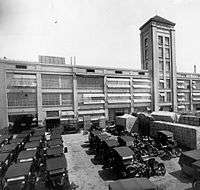
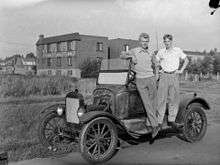
The Ford Model T was the first automobile built by various countries simultaneously since they were being produced in Walkerville, Canada and in Trafford Park, Greater Manchester, England starting in 1911 and were later assembled in Germany, Argentina,[48] France, Spain, Denmark, Norway, Belgium, Brazil, Mexico, and Japan, as well as several locations throughout the US.[49] Ford made use of the knock-down kit concept almost from the beginning of the company as freight and production costs from Detroit had Ford assembling vehicles in major metropolitan centers of the US.
The Aeroford was an English automobile manufactured in Bayswater, London, from 1920 to 1925. It was a Model T with distinct hood and grille to make it appear to be a totally different design, what later would have been called badge engineering. The Aeroford sold from £288 in 1920, dropping to £168-214 by 1925. It was available as a two-seater, four-seater, or coupé.[50]
Advertising and marketing
Ford created a massive publicity machine in Detroit to ensure every newspaper carried stories and advertisements about the new product. Ford's network of local dealers made the car ubiquitous in virtually every city in North America. A large part of the success of Ford's Model T stems from the innovative strategy which introduced a large network of sales hubs making it easy to purchase the car.[10] As independent dealers, the franchises grew rich and publicized not just the Ford but the very concept of automobiling; local motor clubs sprang up to help new drivers and to explore the countryside. Ford was always eager to sell to farmers, who looked on the vehicle as a commercial device to help their business. Sales skyrocketed – several years posted around 100 percent gains on the previous year.
Car clubs
Cars built before 1919 are classed as veteran cars and later models as vintage cars. Today, four main clubs exist to support the preservation and restoration of these cars: the Model T Ford Club International,[51] the Model T Ford Club of America[52] and the combined clubs of Australia. With many chapters of clubs around the world, the Model T Ford Club of Victoria[53] has a membership with a considerable number of uniquely Australian cars. (Australia produced its own car bodies, and therefore many differences occurred between the Australian bodied tourers[54] and the US/Canadian cars.) In the UK, the Model T Ford Register of Great Britain celebrated its 50th anniversary in 2010. Many steel Model T parts are still manufactured today, and even fiberglass replicas of their distinctive bodies are produced, which are popular for T-bucket style hot rods (as immortalized in the Jan and Dean surf music song "Bucket T", which was later recorded by The Who). In 1949, more than twenty years after the end of production, 200,000 Model Ts were registered in the United States.[55] In 2008, it was estimated that about 50,000 to 60,000 Ford Model Ts remain roadworthy.[56]
In popular media
- The phrase to "go the way of the Tin Lizzie" is a colloquialism referring to the decline and elimination of a popular product, habit, belief or behavior as a now outdated historical relic which has been replaced by something new.[57][58][59]
- In Aldous Huxley's Brave New World, where Henry Ford is regarded as a messianic figure, graveyard crosses have been truncated to T's. Moreover, the calendar is converted to an A.F. ("After Ford") system, wherein the first calendar year (A.F. 1) leads from the introduction of the Model T (A.D. 1908).
Gallery
Model T chronology
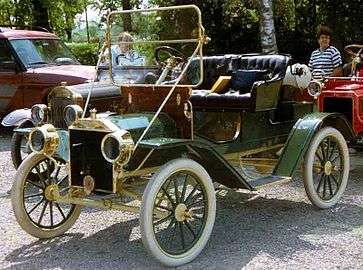 1908 Runabout - Note flat firewall
1908 Runabout - Note flat firewall 1910 Runabout
1910 Runabout 1911 Touring
1911 Touring 1913 Runabout
1913 Runabout 1914 Touring
1914 Touring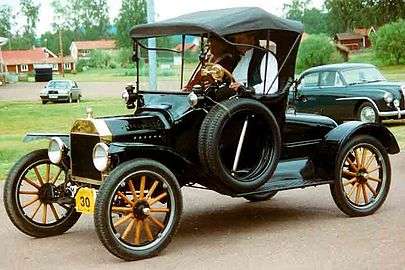 1915 Runabout - Note curved cowl panel
1915 Runabout - Note curved cowl panel- 1916 Touring
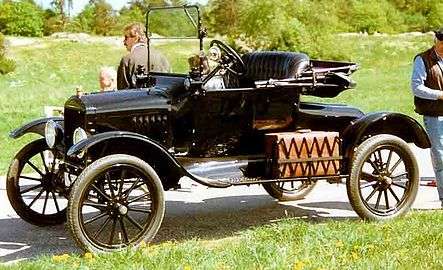 1917 Runabout - Note new curved hood matches cowl panel
1917 Runabout - Note new curved hood matches cowl panel 1919 Runabout
1919 Runabout 1920 Touring
1920 Touring 1921 Touring
1921 Touring.jpg) 1922 flatbed truck
1922 flatbed truck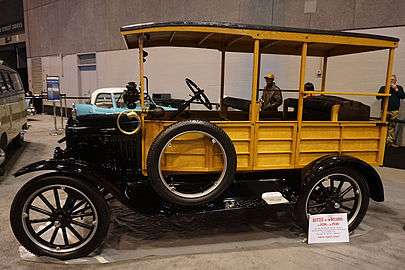 1923 Ford Model T Depot Hack
1923 Ford Model T Depot Hack 1923 Runabout (early '23 model)
1923 Runabout (early '23 model)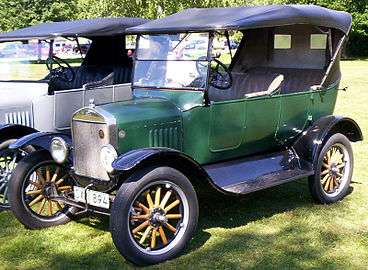 1924 Touring - Note higher hood and slightly shorter cowl panel - late '23 models were similar
1924 Touring - Note higher hood and slightly shorter cowl panel - late '23 models were similar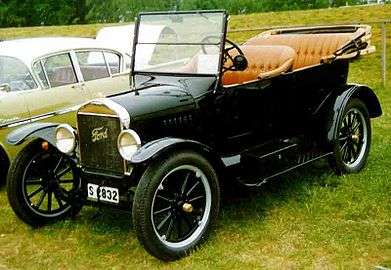 1925 Touring
1925 Touring 1926 Runabout - Note higher hood and longer cowl panel
1926 Runabout - Note higher hood and longer cowl panel 1926 Touring
1926 Touring- 1926 Ford Model T Tudor
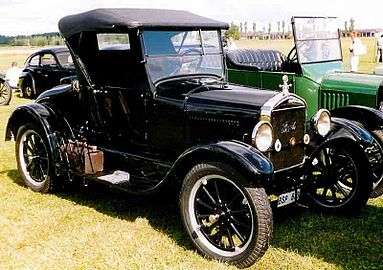 1927 Runabout
1927 Runabout 1928 Ford Model A Tudor Sedan - Shown for comparison, note wider body and curved doors
1928 Ford Model A Tudor Sedan - Shown for comparison, note wider body and curved doors
See also
- New Zealand RM class (Model T Ford) – a 1925 experimental railcar based on a Model T powertrain
- Piper J-3 Cub, the 1930s/40s American light aircraft that developed a similar degree of ubiquity in general aviation circles to the Model T
Notes
- ↑ Boyer, Mike (1998-05-10). "Ford motored into Cincinnati long ago". The Cincinnati Enquirer. Retrieved 2014-08-23.
- ↑ "Ford Model T Plant". Cleveland Historical. Retrieved 2014-08-23.
- ↑ "Ford Model T Assembly Building". MotorTexas. Retrieved 2015-08-04.
- ↑ Darbee, Jeff (July 2014). "City Quotient: I often smell something like vanilla cookies or cake when walking Downtown. Am I just hungry, or is that for real?". Columbus Monthly. Retrieved 2014-08-23.
- ↑ "Ford's System of Branch Assembly Plants". Retrieved 2015-09-15.
- ↑ "Model T Facts" (Press release). US: Forid. Retrieved 2013-04-23.
- ↑ John Steele Gordon (2007-03-01). "10 Moments That Made American Business". americanheritage.com. Retrieved 2012-12-24.
- ↑ Price, R. G. (2004-01-29). "Division of Labor, Assembly Line Thought - The Paradox of Democratic Capitalism". RationalRevolution.net. Retrieved 2015-03-28.
- ↑ Cobb, James G. (1999-12-24). "This Just In: Model T Gets Award". New York Times. Retrieved 2015-03-28.
- 1 2 Folkmann, Mads Nygaard (2011). "Encoding Symbolism: Immateriality and Possibility in Design". Design and Culture. 3 (1).
- ↑ "Top 10 Best Selling Cars of All Time". Autoguide.com. Retrieved 2013-12-02.
- ↑ Curcio, Vincent (2013). Henry Ford. New York: Oxford University Press. ISBN 978-0195316926.
- ↑ "Chronicle of 1908". Library.thinkquest.org. 1908. Retrieved 2012-10-21.
- ↑ "Henry Ford And The Model T". John Wiley & Sons. 1996. Retrieved 2012-12-24.
- ↑ Ritzinger, André. "Early Ford-models from the years 1903–1908". p. 5. Retrieved 2012-12-24.
- ↑ Hounshell, David A. (1984), From the American System to Mass Production, 1800-1932: The Development of Manufacturing Technology in the United States, Baltimore, Maryland: Johns Hopkins University Press, ISBN 978-0-8018-2975-8, LCCN 83016269
- ↑ Ford & Crowther 1922, p. 73.
- ↑ Domm, Robert W. (2009). Michigan Yesterday & Today. Minneapolis: Voyageur Press.
- ↑ "University students compete to create 21st century Model T". Ford. Retrieved 2011-01-17.
- ↑ "History Lesson: Hungary Celebrates the Ford Model T.". India: Federation of Automobile Dealers Associations of India. 2006-02-27. Retrieved 2012-12-24.
- ↑ Wik 1972.
- ↑ Clymer 1950, p. 100.
- ↑ "Model T Facts". Ford. Retrieved 2012-12-24.
- ↑ English, Andrew (2008-07-25). "Ford Model T reaches 100". The Telegraph. Retrieved 2012-12-24.
- ↑ Addison, Keith. "Ethanol fuel: Journey to Forever". Journey to Forever. Retrieved 2012-12-24.
- ↑ http://www.modelt.ca/background.html
- ↑ Transmission bands and linings at FordModelT.net
- ↑ Ford & Crowther 1922, p. 72.
- 1 2 McCalley 1994.
- ↑ Casey, Robert (2008). The Model T A Centennial History. Baltimore: The Johns Hopkins University Press. p. 148. ISBN 978-0-8018-8850-2.
- ↑ "1926 Ford Model T Ice Saw". Owl's Head Transportation Museum. Retrieved 2012-12-24. Used for harvesting winter ice from ponds in Maine.
- ↑ Pripps & Morland 1993, p. 28.
- ↑ Leffingwell 2002, pp. 43–51.
- ↑ "Snowflyers Replace Dogs in Frozen North". Popular Mechanics (December): 878. 1934. Retrieved 2012-12-24.
- ↑ Model T Ford Club of America (2011), Model T Ford Forum: Forum 2011: Old Photo - Model T Rail Car.
- ↑ Georgano 1985.
- ↑ Sandler, Martin (2003). Driving Around the USA: Automobiles in American Life. Oxford University Press. p. 21.
- ↑ Brinkley, Douglas (2003). Wheels for the world: Henry Ford, his company, and a century of progress, 1903–2003. Viking. p. 475.
- ↑ Sorensen, Charles E.; Lewis, David Lanier; Williamson, Samuel T. My forty years with Ford. Wayne State University Press. p. 4.
- ↑ "Last day of Model T production at Ford". History. Retrieved 2015-03-28.
- 1 2 "The Model T Ford". Frontenac Motor Company. Retrieved 2015-03-28.
- ↑ "Last Model T Produced in 1927". Cape Girardeau History and Photos. Retrieved 2015-03-28.
- ↑ "Michigan History". Detroit News. Archived from the original on September 1, 2012.
- ↑ Wagner, Michael F. (2009). Domesticeringen af Ford i Danmark [The domestication of Ford in Denmark]. Denmark: Aalborg University. p. 14. Retrieved 2014-09-06.
Model T production in Denmark stopped in August 1927 for factory recondition.
- ↑ Ward 1974, p. 1562.
- ↑ Lewis 1976, pp. 41–59.
- ↑ "Our Heritage". Kingsford. Retrieved 2012-12-24.
- ↑ "Historia de Ford en Argentina" [History of Ford in Argentina] (in Spanish). Auto Historia. Retrieved 2012-12-24.
- ↑ "Celebrating the Ford Model T, only 100 years young!". Auto Atlantic. 2008. Retrieved 2012-12-24.
- ↑ David Culshaw & Peter Horrobin: The Complete Catalogue of British Cars 1895–1975. Veloce Publishing plc. Dorchester (1999). ISBN 1-874105-93-6
- ↑ "The Model T Ford Club International". Modelt.org. Retrieved 2013-06-02.
- ↑ "Model T Ford Club of America". Mtfca.com. Retrieved 2013-06-02.
- ↑ "Model T Ford Club of Victoria". Modeltfordclubvic.org.au. Retrieved 2013-06-02.
- ↑ "Model T Ford Australian Tourers". Model T Central. Retrieved 2013-06-02.
- ↑ Sedgwick 1972, pp. 50–51.
- ↑ Brooke, Lindsay (2008). Ford Model T: The Car that Put the World on Wheels. MBI Publishing Company. p. 188. ISBN 9780760327289.
- ↑ McColl, Catherine (2003). Happy as the Grass was Green: A Memoir. Trafford Publishing. ISBN 9781412216579.
- ↑ U.S. News & World Report, Volume 105 p. 52 (1988)
- ↑ Fernandez, Margot Biblical Literalism is Headed for a Showdown Which it Will Lose Examiner, March 30, 2011
Bibliography
- Clymer, Floyd (1955). "Henry's wonderful Model T, 1908–1927". New York, NY, U.S.: McGraw-Hill. LCCN 55010405.
- Clymer, Floyd (1950). "Treasury of Early American Automobiles, 1877–1925". New York, NY, U.S.: McGraw-Hill. LCCN 50010680.
- Ford, Henry; Crowther, Samuel (1922), My Life and Work, Garden City, New York, USA: Garden City Publishing Company, Inc. Various republications, including ISBN 9781406500189. Original is public domain in U.S. Also available at Google Books.
- Georgano, G. N. (1985). "Cars: Early and Vintage, 1886–1930". London, UK: Grange-Universal.
- Hounshell, David A. (1984), From the American System to Mass Production, 1800-1932: The Development of Manufacturing Technology in the United States, Baltimore, Maryland: Johns Hopkins University Press, ISBN 978-0-8018-2975-8, LCCN 83016269
- Lacey, Robert (1986). Ford: The Men and the Machine. Boston, MA, U.S.: Little, Brown. ISBN 978-0-316-51166-7.
- Leffingwell, Randy (2002) [1998], Ford Tractors, Borders, ISBN 0-681-87878-9.
- Lewis, David (1976). The Public Image of Henry Ford: An American Folk Hero and His Company. Detroit, MI, U.S.: Wayne State University Press. ISBN 978-0-8143-1553-8.
- McCalley, Bruce W. (1994). Model T Ford: The Car That Changed the World. Iola, WI, U.S.: Krause Publications. ISBN 0-87341-293-1.
- Pripps, Robert N.; Morland, Andrew (photographer) (1993). Farmall Tractors: History of International McCormick-Deering Farmall Tractors. Farm Tractor Color History Series. Osceola, WI, U.S.: MBI. ISBN 978-0-87938-763-1.
- Reynolds, David (2009). America, Empire of Liberty: A New History of the United States. Basic Books. ISBN 978-1-84614-056-3.
- Ross, Irwin (November 1974). "Ford's Fabulous Flivver". Gas Engine Magazine. Retrieved August 11, 2016.
- Sedgwick, Michael (1972) [1962]. Early Cars. Octopus Books. ISBN 0-7064-0058-5.
- Ward, Ian (ed) (1974). "The World of Automobiles". 13. London, UK: Orbis.
- Wik, Reynold M. (1972). Henry Ford and Grass-Roots America. Ann Arbor, MI, U.S.: University of Michigan Press. ISBN 978-0-472-97200-5.
External links
| Wikimedia Commons has media related to Ford Model T. |
- FordModelT.net – Resource for Model T Owners and Enthusiasts
- Model T Ford Club of America (USA)
- Model T Ford Club International
- Ford Model T at the Internet Movie Cars Database
- First and second web pages of Old Rhinebeck Aerodrome's vintage vehicle collection, featuring five Model T-based vehicles
| Ford Motor Company vehicle timeline, North American market, 1903–1942 — next » | ||||||||||||||||||||||||||||||||||||||||||||||||||
|---|---|---|---|---|---|---|---|---|---|---|---|---|---|---|---|---|---|---|---|---|---|---|---|---|---|---|---|---|---|---|---|---|---|---|---|---|---|---|---|---|---|---|---|---|---|---|---|---|---|---|
| Type | 1900s | 1910s | 1920s | 1930s | 1940s | |||||||||||||||||||||||||||||||||||||||||||||
| 3 | 4 | 5 | 6 | 7 | 8 | 9 | 0 | 1 | 2 | 3 | 4 | 5 | 6 | 7 | 8 | 9 | 0 | 1 | 2 | 3 | 4 | 5 | 6 | 7 | 8 | 9 | 0 | 1 | 2 | 3 | 4 | 5 | 6 | 7 | 8 | 9 | 0 | 1 | 2 | |||||||||||
| Chassis | Various | Model T | Model A | 1932 Ford | 1935 Ford | 1937 Ford | 1941 Ford | |||||||||||||||||||||||||||||||||||||||||||
| Runabout | Model A | |||||||||||||||||||||||||||||||||||||||||||||||||
| Model AC | ||||||||||||||||||||||||||||||||||||||||||||||||||
| Model C | ||||||||||||||||||||||||||||||||||||||||||||||||||
| Touring | Model B | Model F | ||||||||||||||||||||||||||||||||||||||||||||||||
| Model K | Model T | |||||||||||||||||||||||||||||||||||||||||||||||||
| Model N | ||||||||||||||||||||||||||||||||||||||||||||||||||
| Model R | ||||||||||||||||||||||||||||||||||||||||||||||||||
| Model S | ||||||||||||||||||||||||||||||||||||||||||||||||||
| Full-size | Model T | Model A | Model B | Model 18 | Model 40 | Model 48 | Standard | Standard | ||||||||||||||||||||||||||||||||||||||||||
| De Luxe | Deluxe | |||||||||||||||||||||||||||||||||||||||||||||||||
| Pickup Truck | Model TT | Model AA | Model BB | Model 48 | Standard | Standard | ||||||||||||||||||||||||||||||||||||||||||||
| Model T | Model A | Model B | Model 18 | Model 40 | De Luxe | Deluxe | ||||||||||||||||||||||||||||||||||||||||||||
| Bus | Transit Bus | |||||||||||||||||||||||||||||||||||||||||||||||||